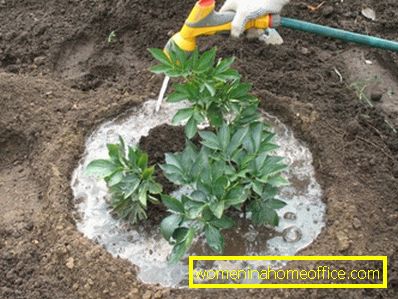Peony care after flowering
Peonies are noble flowers that embody wealth and success. They are unpretentious in the care. This plant is known since ancient times, its birthplace is China. Until now, in this country love and honor these flowers. Peonies are a symbol of nobility. They protect their owner from evil spirits and diseases, symbolize manhood, love and glory.
Pruning peonies after flowering
An important step in the care of peonies after flowering is spring pruning of flowers. If you want to admire lush buds for a long time, you need to remove sluggish branches and leaves of the plant. So you provide the possibility of the development of lateral processes.

Part of the stem with 3 leaves must necessarily remain when pruning. Uncut will have to leave at least half of the stems, otherwise the buds will become weak and small. This will adversely affect the flowering of peonies in the future.
Pruning after flowering should be done in the opening phase of the bud. Store cut peonies recommended in the refrigerator or cellar. The main thing - to prevent the accumulation of moisture on them.
Peonies: features of care
- Caring for flowers is not so difficult. The main difficulties occur in the first 3 years of development and consist in regular loosening of the soil. Cultivation begins in spring and continues during the growing season.. After the rain, be sure to loosen the soil to avoid the formation of a crust on the surface. Soil needs to be dredged to a depth of about 10 cm. Loosening is necessary for the flower to retain moisture and control weeds. The weeds pull nutrients out of the soil, absorb water and promote the spread of disease.
- Peonies need comfortable supports to prevent the stems from breaking up. After 3 years, the flowers need to be seedbed, removing the buds on the stems, leaving two central buds. If you do it right, the flowers will be large and healthy.
- Provide regular watering to peonies., which is necessary to increase in hot and dry weather, as well as before flowering. Water should not fall on the leaves in sunny weather, otherwise they will burn.
- In the first year of life pionies do not need additional feeding. For 2 and 3 years, you can fertilize the flowers with nitrogenous fertilizers (urea, crystalline, mullein solution or pinch of boron).

Peonies: reproduction
Like many tree peonies propagate by dividing the bushes. The best time to breed is autumn.
The flower must be dug, washed the ground, cut off the diseased roots, and the rest divided so that each part of the bush has a good tuber with roots. Disinfect the separated roots and plant each part of the bush into the soil. Peonies are planted in shaded areas with nutrient soil.
In addition to dividing the bushes, new plants can be obtained by grafting. It is better to conduct grafting after flowering. Carefully break off the shoot with the kidney and maternal tissue. Plant a sapling in a shaded place in the same way as a shrub. After 2 years, the plant will be ready for planting in a permanent place.
Peonies: diseases and pests
- Gray rot - a disease that affects young shoots. You can find an ash-gray fluffy bloom on the leaves. Brown spots will appear near the roots. The diseased plant is recommended to be dug and burned so that the rot does not spread to other flowers. To prevent disease, peonies are sprayed with Bordeaux liquid.
- Anthracnose. During this disease, red-brown spots appear on the stems and leaves, which gradually increase. To get rid of anthracnose, it is recommended to cut and burn the affected areas of the flower.

- Rust. You will see yellow-brown spots on the leaves, and on the underside of the depressed areas covered with felt bloom.
- Stem rot. A sign of the disease is wilting of young stems. Affected shoots must be cut and burned. The soil around the bush is replaced with a new one.
- Peony rot - a disease that affects the entire plant. It is useless to fight it, so it is easier to dig up and burn the infected plant.
- The root nematode. The disease harms the roots. As a result, the plant rots and dies. Nematodes are worms that are smaller than 1 mm.
- Bronzing is a large golden beetle that reaches 2 cm in length. It eats away the core of the flower, and the larva gnaws its roots. To get rid of the insect is quite difficult, it must be collected from the plant manually. It is recommended to do this in the morning when the beetles are inactive.
- Leaf nematode, manifested in dark spots between the veins on the leaves. With a strong defeat the leaves begin to die off and fall off. It is recommended that the affected areas be removed from the stem and burned.
- Hop fine tune - these are caterpillars that strike the roots of peonies. To get rid of insects, add TMTD to the soil at the rate of 5 g per shrub.
Growing peonies is an exciting experience. Care for them is not difficult, so they are often planted in suburban areas, people who appreciate the beauty and their time. In response to your care, peonies will delight you with lush elegant buds of delicate and subtle shades.